When it comes to looking after your pet bird, ensuring a regular bird nail trim is as crucial as providing the right diet or a comfortable habitat. Have you noticed your feathered friend having difficulty perching, or are they catching on objects more frequently? These could be signs that it’s time to schedule a nail care session for your healthy bird. Proper bird care, which includes regular nail trims, is vital for avian health and can prevent long nails from curling or causing foot discomfort. As a dedicated pet owner, knowing when to conduct a trim is important for maintaining your bird’s welfare and keeping your interactions safe and enjoyable.
Key Takeaways
- Regular nail trims are essential for preventing curled nails and ensuring the avian health of your pet bird.
- Long nails that catch on objects can indicate that it’s time to trim your bird’s nails.
- Difficulty perching or noticeable changes in your bird’s behavior are signs of potential foot discomfort from overgrown nails.
- Monitoring your bird’s nail length will help you maintain a healthy bird by preempting issues that arise from neglect.
- Avoiding scratches and injuries either to yourself or the bird is important when considering a bird nail trim.
Understanding Bird Nail Health and Maintenance
As a discerning pet owner, you’re likely familiar with the basics of bird care—from their diet to their living arrangements. However, the intricacies of bird nail care may not be as well-known. The state of your bird’s nails can deeply impact its quality of life, indicating more about their overall health than you might think. Let’s delve into the essentials of maintaining your bird’s nail health, ensuring they remain a happy, healthy bird.
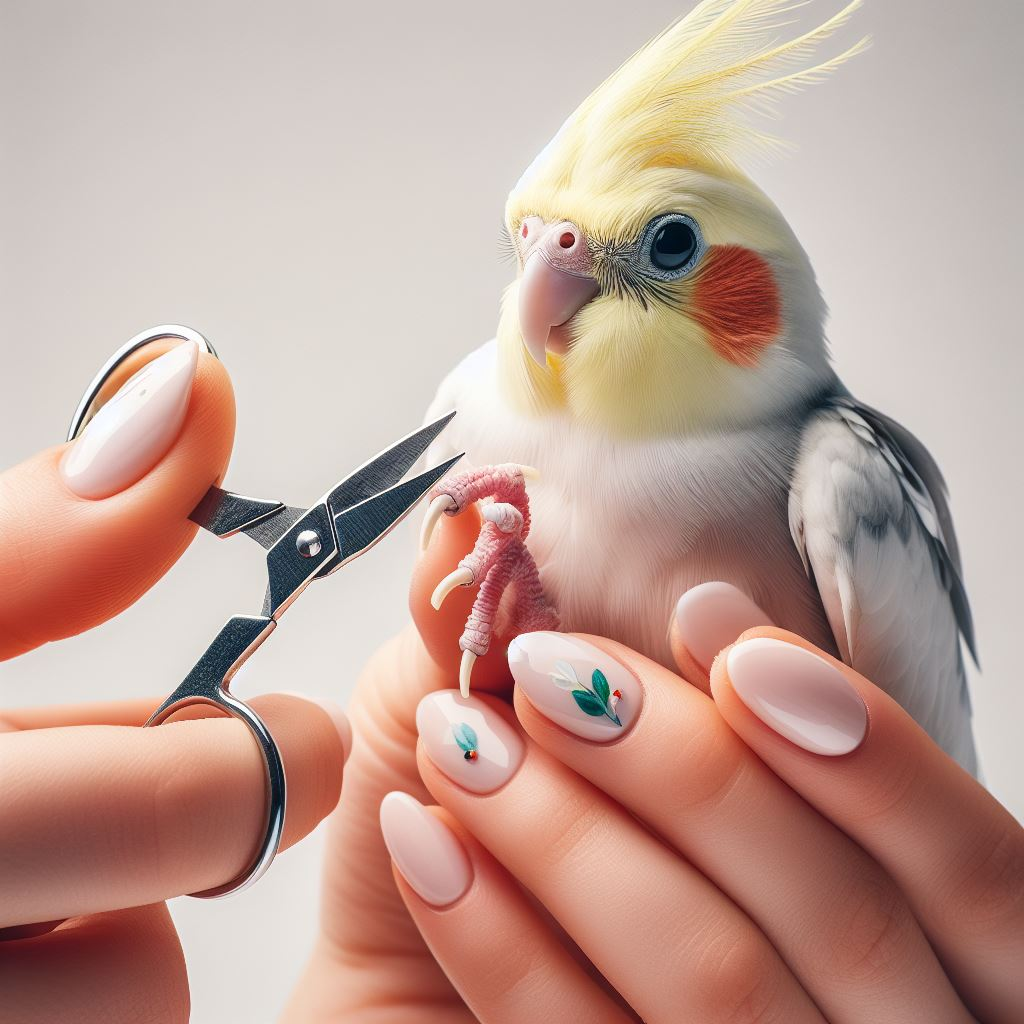
It’s all about balance when it comes to when to trim bird nails. You want to avoid the pitfalls of overgrooming just as much as those of neglect. Regular checks will help you recognize when their nail length begins to compromise their well-being and necessitate maintenance.
Assessing Your Bird’s Anatomy for Nail Trim Necessity
First up in bird nail maintenance is understanding your bird’s anatomy, including the baseline of what’s normal for their nails. Each species of bird will have different nail growth patterns, so what is considered overgrown bird nails for one may be completely normal for another. Observing and feeling your bird’s feet with gentle care will guide you in determining when those claws are due for a trim. It’s a good practice to have your veterinarian show you what to look out for during your regular health check-ups.
Normal vs. Overgrown Bird Nails
So, how can you tell if your bird’s nails have crossed the line into overgrown territory? There are several clues you can look for. Nails that seem too curved or hinder your bird from perching comfortably are likely too long. Also, excessive nail length might lead to your bird’s nails getting caught on fabric or causing scratches to both you and your feathered friend. If these signs are evident, it could be time for some bird nail maintenance.
Your proactive approach to keeping an eye on the length and condition of your bird’s nails is a surefire way to perceive the need for a trim before it becomes a pressing issue. Regular nail trims contribute to a healthy bird and a harmonious pet-owner relationship. Keep these guidelines in mind, and your bird will be set to continue flitting and perching happily in its well-maintained environment.
6 signs your bird needs a nail trim
When it comes to bird nail health, being observant can make all the difference. Just as humans require regular nail care, birds also benefit from consistent nail maintenance to prevent overgrown bird nails and associated complications.
Your bird’s activities should be effortless and their perching, graceful. If you’ve noticed a struggle or a reluctance in these simple joys, it might indicate difficulty perching. Identifying and understanding these key signs will not only ensure a comfortable life for your companion but also protect you from injuries and improve interaction with your pet.
Watch for these six crucial signs that signal it’s time for a bird nail trim:
- Excessive Nail Length: Take note if your bird’s nails appear longer than usual, starting to curl or interfere with their movement.
- Changes in Perching Behavior: A shift in how your bird stands or perches, favoring one foot, or taking to the cage floor, may point to foot discomfort resulting from long nails.
- Nails Catching on Surfaces: Overgrown nails may snag on fabrics or the cage, causing stress and potential injury.
- Visible Skin Issues: If your bird is showing signs of self-mutilation due to discomfort such as sores, it might be a reaction to overgrown nails.
- Handling Discomfort: When holding your bird causes scratches or is painful, this might be a cue for a trim.
- Noticing Scratches on Your Hands: This can be more than a minor inconvenience; it’s a sign that your bird’s nail care needs immediate attention.
These signs are indicative that a nail trim would not only alleviate immediate discomfort but could also prevent more serious issues from developing. Regular nail trims contribute to your bird’s overall health and can diminish the risk of injuries for both your bird and yourself.
As a general rule, we take our Green Cheek Conure (Skittles) every three months to have his nails trimmed.
Now is a perfect time to inspect your avian companion’s claws. Should you spot any of the signs mentioned, it may be wise to schedule a trim or consult with your veterinarian for advice on the best care practices.
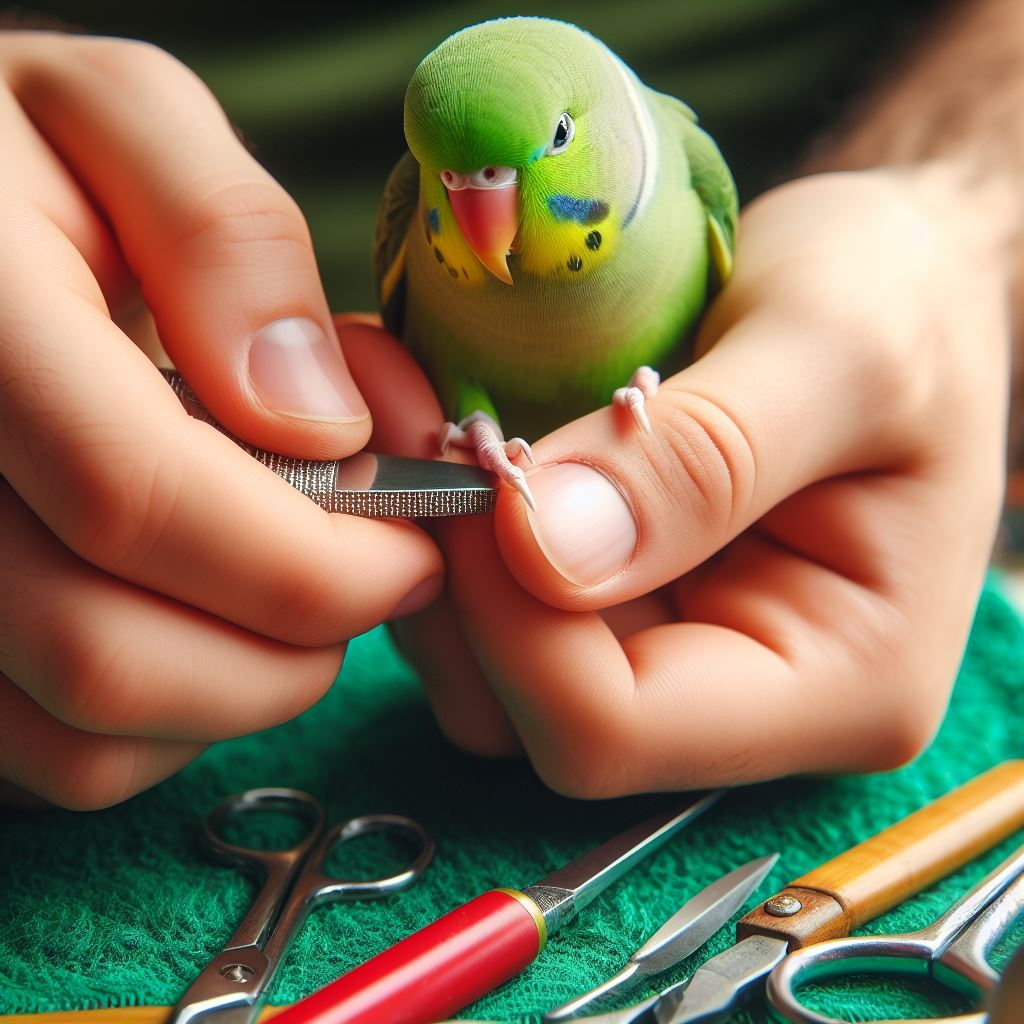
A bird nail trim doesn’t have to be a distressing ordeal for your pet. By making nail care a regular part of your routine and recognizing signs early on, you can keep your bird’s nails neat, prevent foot discomfort, and enjoy your interaction without the risk of scratches or further complications.
Remember, the health of your bird’s nails plays a pivotal role in their overall well-being. With attentive care and maintenance, your bird can continue to explore their surroundings with ease and comfort.
If you are unsure about handling this, there’s no shame in reaching out for professional assistance. A skilled avian veterinarian or an experienced groomer can perform a nail trim safely, ensuring the optimal bird nail health for your feathered friend.
Changes in Perching Behavior: A Red Flag for Nail Care
Observant bird owners know that a bird’s perching habits offer valuable clues to its overall well-being. When your usually agile feathered friend starts exhibiting difficulty perching, it might be more than just an off day—it could signal that its time for some bird nail care. Ignoring these signs can lead to foot discomfort or worse, impede avian health.
Identifying Discomfort in Bird’s Perching Habits
If perch-time seems less enjoyable for your bird, it’s important to be on the lookout for any hesitancy or awkwardness. When nails become too long, they can interfere with the natural grip on perches, leading to potential discomfort. Has your bird been clinging to the side or bottom of the cage rather than standing proudly on its perch? These could be indications that it’s struggling to maintain balance due to overgrown nails.
Implications of Favouring One Foot Over Another
Just as you might limp when suffering from a sore foot, birds might favor one foot over the other when experiencing pain. Regularly catching on objects or a noticeable preference for one foot may point to an underlying issue that requires immediate attention, possibly a nail trim. Scheduling regular bird nail maintenance checks can preempt further issues and ensure your bird continues to enjoy its perching and climbing activities.
| Sign | Explanation | Recommended Action |
|---|---|---|
| Difficulty Grasping Perches | Nails too long to allow a comfortable grip | Examine nails and trim if necessary |
| Favoring One Foot | Possible pain or discomfort in one foot | Check feet for injuries and consult a vet |
| Reluctance to Perch | Preference for cage floor due to discomfort | Assess nail length and trim if overgrown |
Birds cherish their perches as homes within homes, where they feel secure and in control. If perching patterns change, don’t hesitate to act. By staying vigilant and responsive to these changes, you’ll be ensuring the health and happiness of your avian companion.
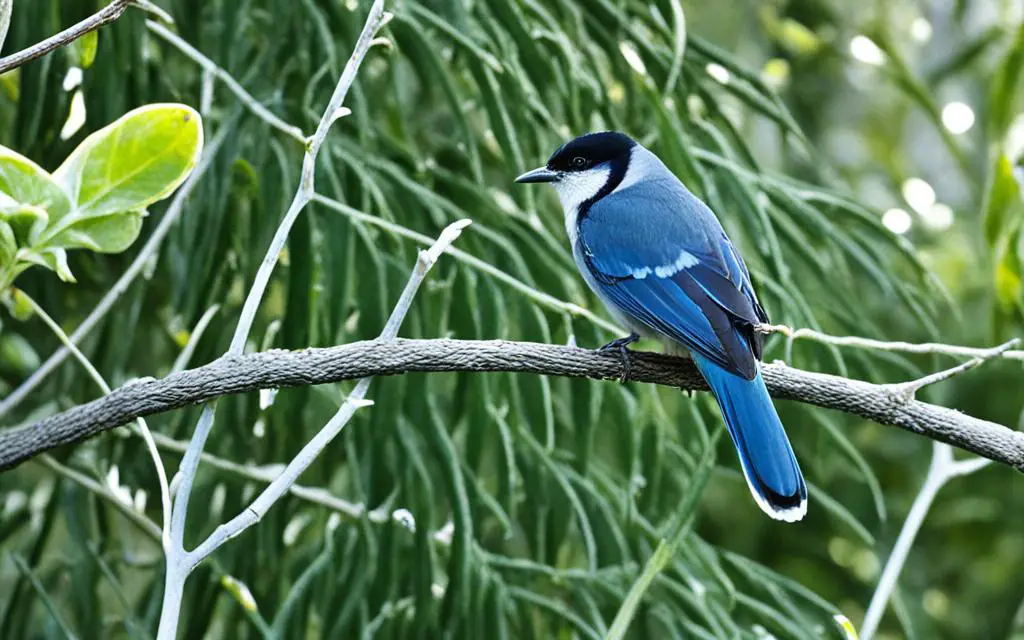
The Dilemma of Overgrown Bird Nails: Mobility and Lifestyle Impact
In the world of bird care, the issue of overgrown bird nails is not merely an aesthetic concern—it’s a mobility and lifestyle challenge for your avian companion. Just as you rely on the condition of your feet to take you places, birds depend on the health and maintenance of their nails to interact with their environment, from gripping perches to navigating their living space.
Imagine you’re wearing shoes that are too long or have excessively long soles; you’d likely trip or catch on carpets, wouldn’t you? Similarly, birds with long nails face an array of difficulties, including catching on objects like cage bars, toys, or even your clothes. These complications can not only cause discomfort but also hamper the bird’s intrinsic behaviors, like climbing or playing, which are vital to their physical health and emotional contentment.
Difficulty perching is another sign that your feathered friend may be grappling with nail troubles. The simple joy of perching, which seems as effortless as sitting on a chair for humans, becomes a cumbersome and perhaps painful task for birds when their nails are in need of a trim. It’s equivalent to trying to balance on stilts—certainly not an environment conducive to relaxation or safety!
Now, consider the prospect of timely bird nail maintenance. Regular trims play a preventative role and eliminate the risk of mobility issues that stem from overgrown nails. The goal is to sustain a level of personal grooming for your bird that mirrors its wild instincts. Subsequent to a well-executed nail trim, you’ll notice an immediate difference: a happier bird that glides to its perch with grace and plays without hindrance.
| Issue with Overgrown Nails | Impact on Bird | Benefit of Trimming |
|---|---|---|
| Catching on textiles and objects | Possible entrapment and injury | Freedom from snags and added safety |
| Difficulty perching and climbing | Decreased mobility and potential foot pain | Better grip and happy perching moments |
| Impediment to natural behaviors | Behavioral changes due to discomfort | Stress-free play and natural activity |
By embracing ongoing avian health practices including nail maintenance, you ensure that your bird’s movement remains unobstructed, allowing it to live a life that’s as close to its natural state as possible. After all, the quintessence of responsible bird care lies in providing an environment that fosters both their physical agility and their spirited play.
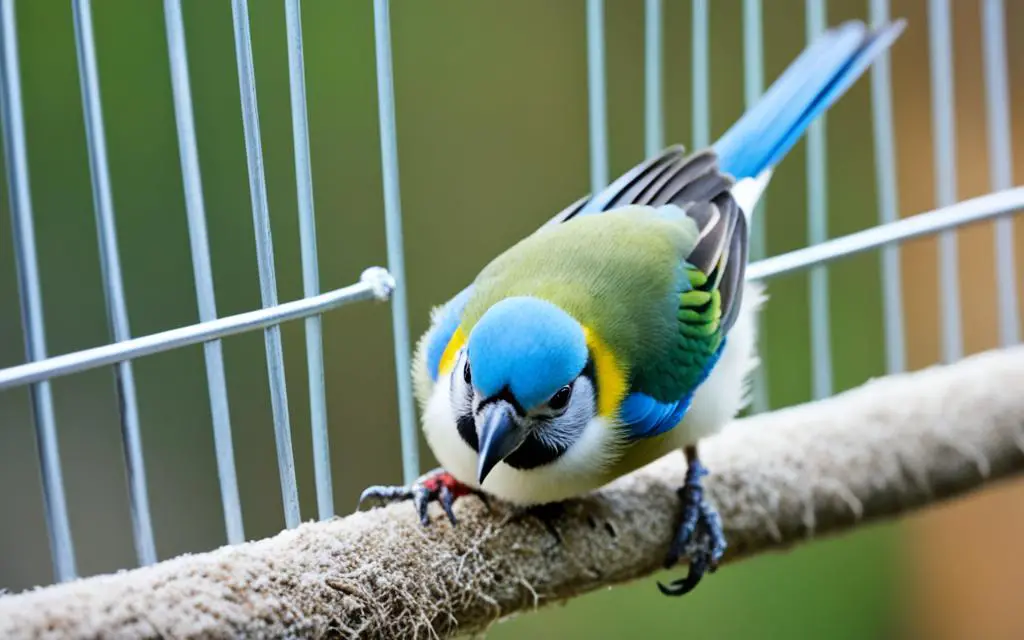
Recognizing the Signs of Foot Injuries and Skin Issues
When it comes to the care of your pet bird, observing for signs of foot discomfort and skin issues due to over-scratching is essential. These indicators often manifest when nail trim for birds is overdue, leading to self-inflicted injuries. As an avian owner, being vigilant about these signs helps ensure you are providing the level of bird grooming needed for a content and healthy pet.
Scratching-Related Sores and the Necessity for a Nail Trim
If you spot your bird frequently over-scratching or notice rough patches on its skin, these are clear signs that your avian friend may be in distress due to overgrown nails. Such nails can become sharp weapons against their own skin, creating sores or dermal abrasions that can even lead to bleeding. To prevent further injury and ensure your bird remains comfortable, a timely nail trim conducted with care is crucial.
The Importance of Prompt Veterinary Attention for Persistent Skin Problems
In instances where your bird’s skin does not heal post-trim, or if you recognize persistent skin issues, seeking the expertise of an avian veterinarian is imperative. These skilled professionals can provide appropriate care and advice, potentially preventing more severe health issues. For problems that persist or seem out of the ordinary, do not hesitate; immediate professional attention is vital for the health and comfort of your bird.
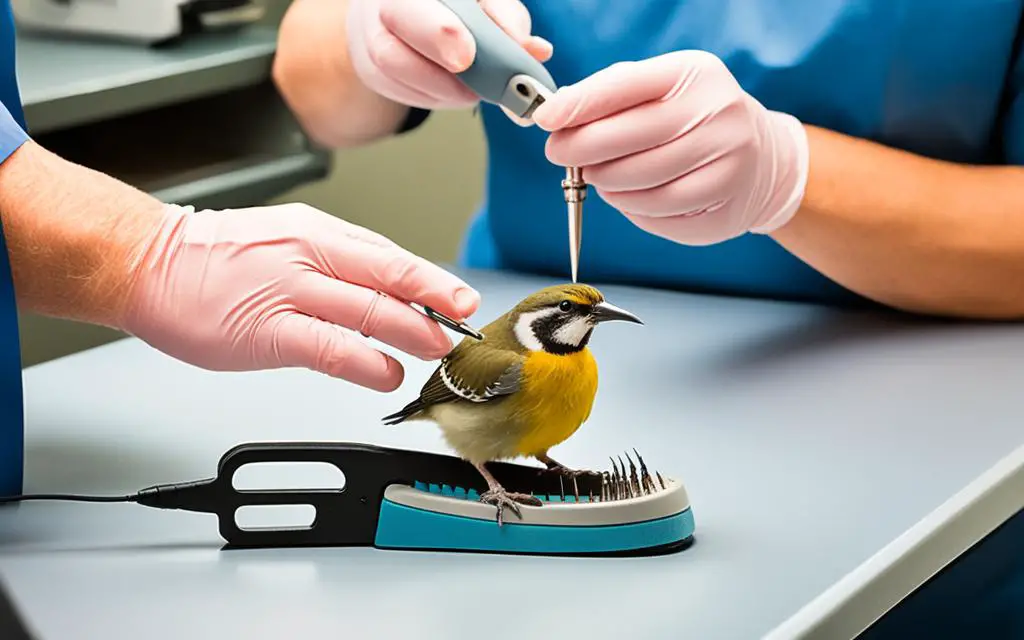
Remember, the inclination to scratch can cause more than superficial damage if left unchecked, so regular nail maintenance should not be overlooked. Conscientious bird grooming, which includes periodic nail trimming, is a necessary aspect of responsible pet care that helps prevent injuries and upholds the well-being of your beloved feathered companion.
Nail Length and Handling Comfort: Time for a Trim?
When it comes to the health and well-being of your pet bird, maintaining the proper nail length is crucial—not only for its own comfort but also to ensure safe and pain-free handling for you. If you find yourself reluctant to interact with your bird due to the sharp prick of its nails, it may indicate that it’s time to address the nail lengths. A bird’s nails should not impede your ability to enjoy time with your feathered companion. It’s all about finding the balance between care and comfort, for both you and your pet.
Distinguishing Between Safe and Harmful Nail Lengths
Understanding the difference between safe nail lengths and long nails that can cause injury is vital for responsible bird handling. When the nails of your bird have crossed the threshold to being harmful, they can cause scratches and discomfort not only to you but to the bird itself. By regularly inspecting your bird’s nails, you can prevent the negative effects of the nails becoming excessively long and sharp.
When Bird Handling Becomes Painful
If holding your bird causes discomfort or injury to your skin, this distress sign should not be overlooked. It’s essential to schedule a bird nail trim if you find the experience painful or if you observe that your bird is struggling due to the length of its nails. The routine of nail trimming for birds can transform handling from a cautious chore into a delightful way of bonding with your bird.
| Nail Assessment Criterion | Indicators of Trimming Necessity | Handling Effects | Actions to Take |
|---|---|---|---|
| Visual Length Check | Nails extend beyond the toe | Scratches on hands during handling | Schedule trim; consult vet if unsure |
| Physical Comfort Test | Causes pain or catches material | Handling avoidance; clothing snags | Immediate trimming required |
| Behavioral Observations | Changes in perching; foot favoring | Reluctant interaction; stress signs | Evaluate for nail trim; monitor behavior |
By keeping a keen eye on these indicators, you will enable stress-free interactions with your bird, thus optimizing your shared environment for happiness and health. Take time to gently handle and inspect your bird’s feet, making nail trimming for birds a painless and infrequent necessity rather than a regular burden. After all, your attentiveness to nail maintenance is a reflection of the affection and responsibility you bear as a pet owner.
The Nail Trimming Process: Ensuring a Positive Experience
Mastering how to trim bird nails can significantly affect the health and happiness of your pet bird. With the right approach and tools, the nail trimming process doesn’t have to be stressful for either of you. Here’s how to ensure a positive experience for your feathered friend’s next manicure session.
Choosing the Right Tools for a Safe Nail Trim
Selecting the appropriate instruments is the first critical step toward a successful bird nail trim. You might prefer traditional nail clippers designed for birds or opt for a nail grinder for a smoother finish. Whatever tool you decide on, it should be sharp and precise to avoid splitting the nail, which could lead to discomfort or infection.
Equally important is to have styptic powder within reach—just in case. This special powder quickly stops bleeding if the quick is accidentally nicked. It’s better to be safe than sorry, so having it on hand will give you peace of mind during the nail trimming process.
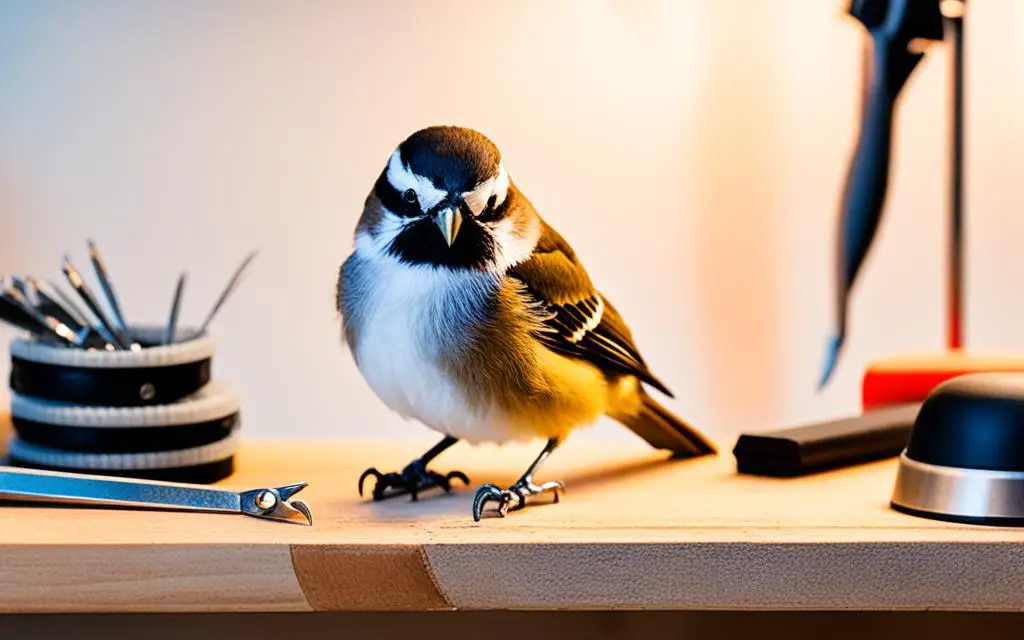
Training Your Bird and Yourself for Nail Trimming Sessions
Preparing for a trim involves creating a calm environment and training the bird for nail trims. This may take time and patience, with positive reinforcement as a key factor. Before you even start trimming, get your bird accustomed to having its feet handled. Offering treats and praise during and after handling can go a long way toward making the actual trimming process smoother.
When it’s time for the nail trim, gently wrap your bird in a soft towel to minimize stress and to secure a firm yet comfortable hold. This helps prevent flapping or injury. Aim to trim only the pointy tips of the nails, being careful not to get too close to the quick—the pink area within the nail that contains blood vessels and nerves.
The art of calming and reassuring your bird cannot be understated. Talk softly and provide comfort throughout the procedure. After you’re done, reward your brave buddy with its favorite treat. This helps associate the nail trimming process with a positive outcome, which will make future trims much easier.
Remember: Nail trims are not just about aesthetics; they’re integral to your bird’s health and mobility. By carefully choosing the right tools and training your bird, you turn what could be a daunting task into a routine act of care—keeping your pet bird nimble, comfortable, and most importantly, happy and healthy.
Considering Safety: Preventing Injury During Nail Trims
When it comes to your bird’s grooming, preventing injury during a nail trim is key. Ensuring the well-being of your companion requires avoiding the quick, the sensitive part of the nail where nerves and blood vessels are present. Achieving this can be a fine balance, but with the right approach and using appropriate tools, you can maintain both ease and safety.
Here are essential steps to help you navigate bird nail care with a safety-first mindset:
- Prepare by having styptic powder on hand, which aids in stopping bleeding should you accidentally cut into the quick.
- Wrap your bird gently in a towel. This helps to soothe them and reduce movement, allowing for a more controlled trim.
- Be cautious and observe the coloration of your bird’s nails, if visible, to identify where the quick ends, especially if they have light-colored nails.
- Utilize appropriate tools designed for bird nail care, ensuring they are clean and sharp.
- Trim only the tips of the nails to avoid the quick, making sure to reassure your bird with a calm voice throughout the process.
Ensuring the safety of your bird during nail trimming can be a stress-free process by embracing these measures. Additionally, establishing a routine will make the trims predictable, thereby reducing anxiety for both you and your bird over time.
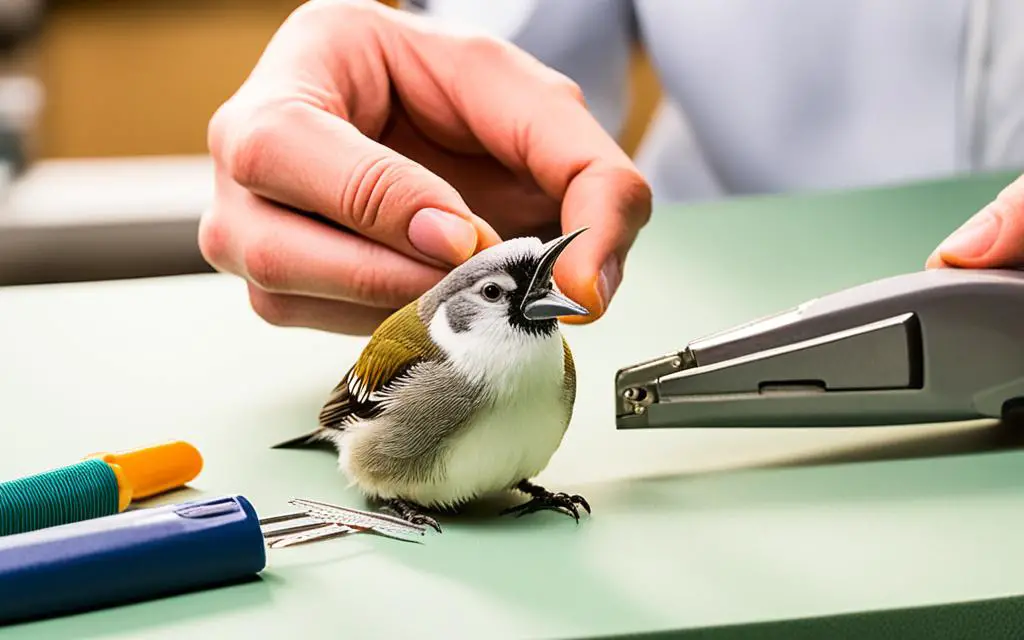
Maintaining a regular schedule and knowing the signs of when a trim is necessary can help prevent the likelihood of cutting too short. However, should an accident occur, knowing how to stop the bleeding quickly and effectively is paramount.
Whether you’re a seasoned bird owner or a newcomer, always remember that the best approach to bird grooming is proactive and preventative care. By doing so, you’ll be upholding the highest standards of responsible pet care and fostering a happy, healthy life for your feathered companion.
When to Seek Professional Help for Your Bird’s Nail Care
It’s a shared experience among bird owners—the moment you realize that your feathered companion needs a parrot nail trim or a cockatiel nail trim, yet the task feels daunting. This is when seeking professional help from an avian veterinarian becomes not only prudent but necessary for responsible pet care. As nurturing caretakers, acknowledging our limits and opting for expert bird grooming services reflects a commitment to our pet’s well-being.
Situations wherein you may want to consider professional nail care include:
- If your bird is overly stressed or frightened during grooming sessions.
- When you lack the proper tools or confidence to trim the nails without causing injury.
- In the event that your bird has unusually dark nails, making it difficult to see the quick.
- If your bird’s species requires a special grooming approach that you’re not familiar with.
- Whenever you notice that your bird’s nails are continually splitting or breaking despite home care.
- Should there be any bleeding or an indication of infection in the nail or foot area.
Remember, different bird species, such as parrots, cockatiels, or macaws, may have specific requirements when it comes to the frequency and technique of nail trims. An avian veterinarian or a qualified groomer possesses the experience to handle the delicate nature of bird grooming and can also provide valuable insights into maintaining your bird’s health in between trims.
| When to DIY | When to Seek Professional Help |
|---|---|
| Your bird is calm during grooming | Shows signs of extreme stress |
| You have the necessary tools and are skilled in nail trimming | You’re unsure about the safe length to trim |
| You understand your bird’s species-specific requirements | Your bird’s species has special grooming needs |
| The nail trimming process has been consistently successful at home | Recurring issues like nail splitting arise |
Seeking the guidance of professionals for a parrot nail trim or cockatiel nail trim is more than just a convenience—it’s an act of love and responsible pet care. By choosing the safety and health of your bird over uncertainty, you create a nurturing environment where your bird can thrive free from the complications of overgrown nails.
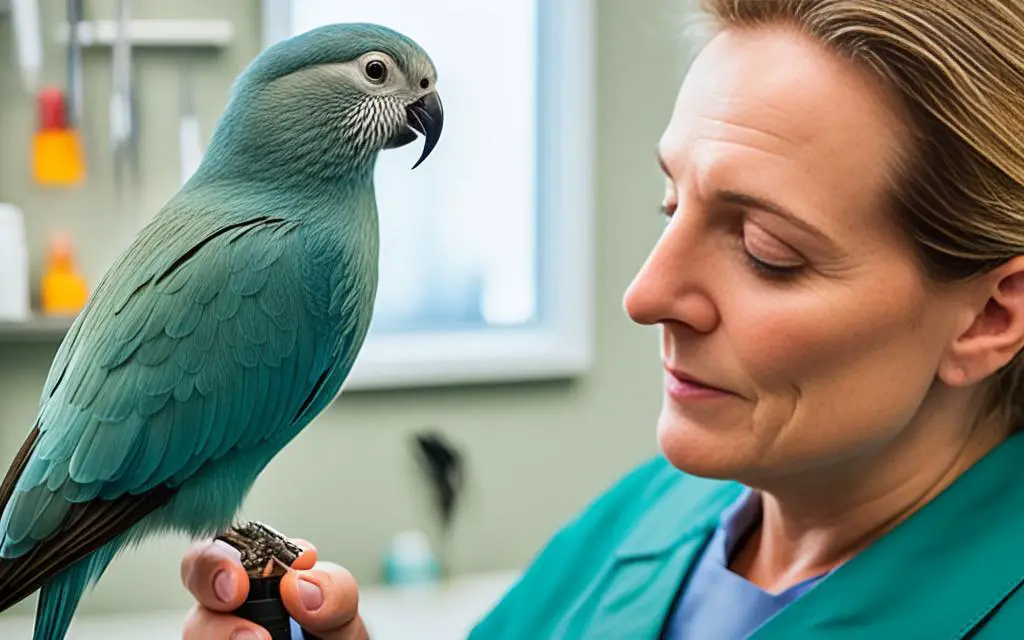
So, if you’re ever in doubt, reaching out to an avian veterinarian or a certified groomer for your bird’s nail care needs is the right step towards ensuring a happy, healthy life for your avian companion. Expert hands can make all the difference in maintaining your bird’s comfort and your peace of mind.
Natural Ways to Maintain Healthy Bird Nails
Just as you take pride in your personal grooming, your pet bird’s nail care is a vital aspect of their overall health. By combining natural practices that promote natural wear, providing a diversified environment, and maintaining a healthy dietary regimen, you can keep your bird’s nails in optimal condition. Let’s explore effective methods that nature itself has perfected for ensuring your bird’s nails stay at a healthy length, reducing the need for manual trims.
Offering a Variety of Perches for Wear and Tear
One of the most effective ways for natural bird nail maintenance is providing perches for natural wear. Different types of perches mimic the diverse surfaces your bird would encounter in their natural habitat. Rough textures such as natural wood or mineral perches can help file down nails simply through everyday activities like perching and climbing. Consider integrating an array of perches with various diameters and materials to facilitate this process effectively.
| Perch Type | Benefits | How It Mimics Nature |
|---|---|---|
| Natural wood | Encourages wear and provides grip | Resembles tree branches |
| Mineral or concrete | Gently files nails during use | Simulates rocky outcroppings |
| Variable diameter | Exercises feet, preventing atrophy | Offers a variable gripping surface just like in the wild |
Such perches not only promote bird enrichment but also serve an essential function in self-grooming and foot health by naturally wearing down nail tips.
The Role of Diet in Avian Nail Health
While a well-designed habitat with appropriate perches is crucial, maintaining a healthy diet is equally important for nail and overall avian health. A balanced diet rich in essential nutrients contributes to strong nail growth. Calcium and vitamins obtained from greens, cuttlebone, and fortified seeds can help maintain healthy nail structure, ensuring they don’t become brittle or overgrow too quickly.
Combining these natural approaches with scheduling regular nail trims, especially for species such as the cockatiel that are known for their fast-growing nails, ensures a comprehensive strategy for nail care. A cockatiel nail trim might still be necessary from time to time, but with these tactics, it will be less frequent and far less stressful for your pet.
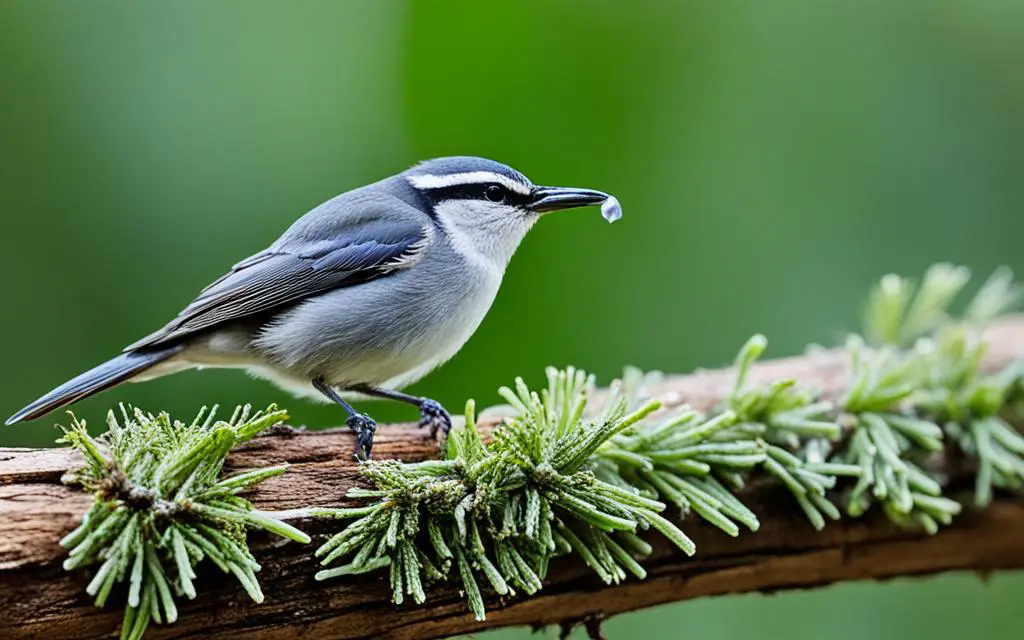
Embracing these natural methods for maintaining your bird’s nails benefits both pet and owner. A little effort in setting up the right living conditions and a balanced menu goes a long way in keeping your bird’s talons in check. Whether you have a playful parakeet or a charming cockatiel, ensuring they have everything they need to flourish is the key to a happy, healthy life together.
Understanding the Risks: Flaking, Catching, and Nail Loss
As a pet bird owner, staying informed about potential bird nail risks is essential in ensuring your bird’s health and well-being. Nails that are not properly maintained can suffer from flaking nails, increased likelihood of catching nails on objects, and even the distressing possibility of nail loss in birds. Taking the right preventive measures and knowing how to respond to nail emergencies can help keep these risks at bay.
How to Prevent Common Nail-Related Injuries
To protect your bird from common nail injuries, it’s important to implement a consistent nail maintenance routine. Regular trimming helps to keep nails at an appropriate length, reducing the chance of flaking or getting snagged on objects within their habitat. Ensuring that your bird’s environment has suitable surfaces and materials that promote natural nail wear can also aid in preventing nail injuries.
Recognizing and Reacting to Nail Emergencies
Despite best efforts, nail emergencies can occur. Recognizing the signs of distress and knowing how to swiftly react to nail emergencies could save your bird from further trauma or infection. In case of bleeding, having a styptic powder handy or knowing the use of cornstarch can be a lifesaver in controlling blood loss. If you encounter a situation where your bird loses a nail or shows signs of severe pain, contacting an avian veterinarian immediately is crucial.
| Issue | Preventive Measures | Emergency Response |
|---|---|---|
| Flaking Nails | Regular trimmings; provide textured perches | Monitor for signs of infection; consult vet |
| Catching Nails | Maintain short nail length; avoid loose threads in toys | Free the nail gently; check for injuries |
| Nail Loss | Prevent trauma by avoiding sharp objects in cages | Apply styptic powder; seek immediate veterinary assistance |
Routine nail care is not only about ensuring a visually tidy appearance but is fundamentally linked to your bird’s ability to navigate and enjoy its surroundings safely. By staying attentive and proactive, you are key to preserving the joy and quality of life for your winged companion.
Regular Inspections: Uncovering Signs of Foot Health Issues
Regular health checks are a cornerstone of responsible pet care, particularly when it comes to maintaining your bird’s foot health. During these evaluations, it’s imperative to be thorough, as this is your opportunity to identify early signs of avian health issues that, if unnoticed, could lead to more serious complications. A focused bird nail check is not only about clipping overgrown nails—it’s about assessing the overall condition of your pet’s feet.
Watch for anything unusual: swelling that could suggest inflammation, any kind of discoloration hinting at possible circulation issues, or lesions that may be indicative of infection or injury. Remember, issues like these demand immediate attention, preferably from an experienced avian veterinarian. Addressing these symptoms promptly can avert more severe health problems and is an integral aspect of bird grooming and welfare.
Creating a routine for these inspections can increase the likelihood of spotting changes early. It’s about being proactive rather than reactive in your approach to bird grooming, fostering a relationship of care that encapsulates more than just standard upkeep. To aid in your diligence, here’s a structure to follow during your regular bird foot examinations:
| Area | What to Look For | What It Might Mean | Recommended Actions |
|---|---|---|---|
| Nails | Abnormal length, sharpness, flaking | Overgrowth, nutritional deficiency, dehydration | Schedule trim, review diet, consult vet |
| Skin & Scales | Discoloration, lesions, roughness | Infection, injury, dermatitis | Immediate vet examination |
| Pads | Swelling, sensitivity, discharge | Pododermatitis, bumblefoot | Clean area, vet visit, habitat modification |
| Joints | Restricted movement, enlargement | Arthritis, injury, gout | Reduce perch diameter, vet evaluation |
By engaging in this level of observation and care, you’re providing your bird with the highest standard of living possible in captivity. Ensuring that regular foot health inspections are a part of your care routine is a testament to your dedication to responsible pet care. Through your vigilance, you’re not just a pet owner—you become the steward of your bird’s health and happiness.
Conclusion
As we’ve explored throughout this guide, understanding and implementing regular bird nail trims are essential components of bird grooming that contribute significantly to avain health. These routine trims not only prevent physical complications caused by overgrowth but also enhance the day-to-day enjoyment and comfort for your happy healthy bird. Incorporating such practices into your regime is a testament to your responsible pet care, assuring a harmonious life for both you and your feathered companion.
Summarizing the Importance of Regular Bird Nail Trims for a Happy, Healthy Pet
Adhering to a schedule of regular bird nail trims does more than just maintain the physical appearance of your bird—it plays a vital role in supporting their overall well-being. Trimming prevents issues such as difficulty perching and scratching, ensuring that your bird can engage in natural behaviors safely and comfortably. An important aspect of bird nail maintenance, the procedure must be performed with care, aiming to mirror the natural conditioning that would occur in the wild.
Encouraging Responsible Bird Grooming Practices Among Pet Owners
Your commitment to a complete bird grooming routine is imperative; it showcases a level of care and dedication that goes beyond the basics. It’s important to remain informed and proactive about the various aspects of bird nail maintenance, extending from regular trims to providing a diversified perch environment and a nutritious diet. Embrace these practices, and you’ll play a pivotal role in fostering a happy, healthy bird that thrives under your guardianship.
FAQ
What are the signs that my bird needs a nail trim?
How do I differentiate between a normal and overgrown nail in birds?
Why is it important to maintain my bird’s nail health?
How can I tell if my bird is having difficulty perching due to nail issues?
What impact do overgrown nails have on my bird’s mobility and lifestyle?
When should I seek professional help for my bird’s nail care?
What tools are necessary for a proper bird nail trim?
Can I train my bird to tolerate nail trims better?
How can I provide for natural nail wear in my bird?
What should I do if my bird has a nail emergency?
How can I ensure the safety of my bird during nail trims?
How does a balanced diet contribute to my bird’s nail health?
How often should I perform nail trims on my bird?
What other foot health issues should I look for during a nail trim?
Source Links
- https://www.thesprucepets.com/how-to-trim-your-birds-nails-390667
- https://www.thesprucepets.com/signs-your-bird-needs-nail-trim-390676
- https://www.bostonveterinary.com/web-tails/bird-nail-trim/

My name is Shane Warren, the author behind Your Bird Buddy – your ultimate guide to the wonderful world of birds! Unleash your inner avian explorer as we delve into a vibrant library of knowledge dedicated to all things feathered. From learning about diverse bird species from across the globe to understanding their captivating habitats and behaviors, I’m here to fuel your passion for these magnificent creatures. Not only that, but I also provide valuable insights on being a responsible and informed pet bird owner. Join our vibrant community and let’s celebrate the feathered wonders of the world together – one chirp at a time. And be sure to join our Your Bird Buddy Community over on Facebook!

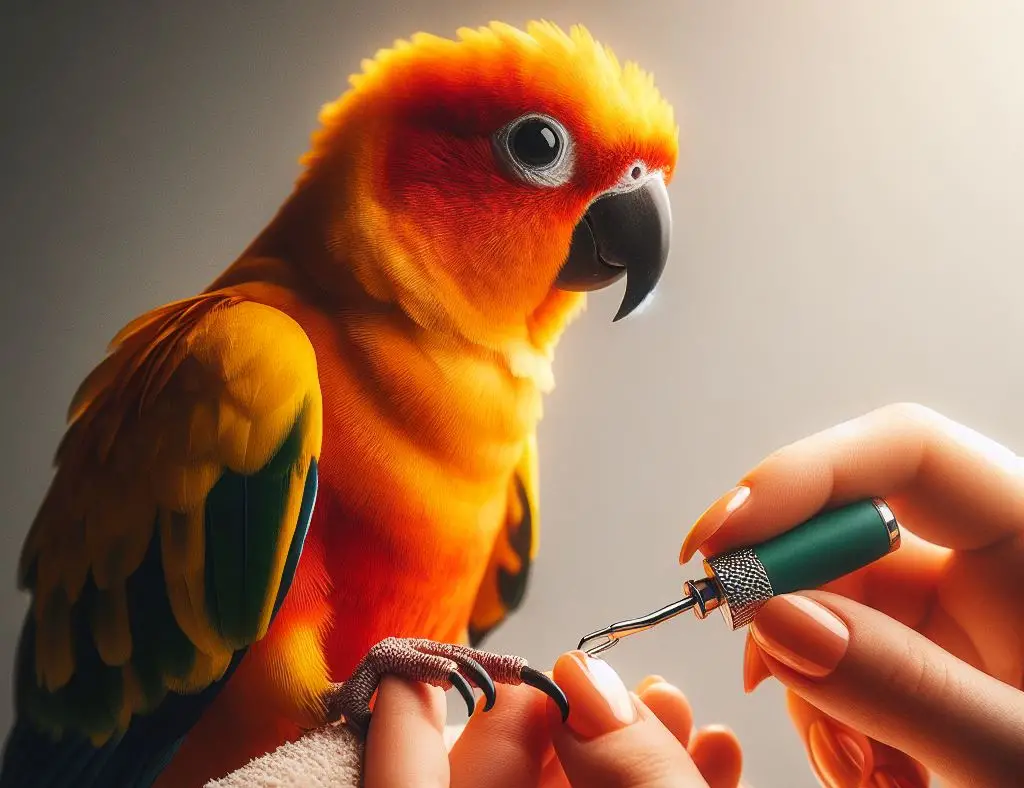
Comments are closed